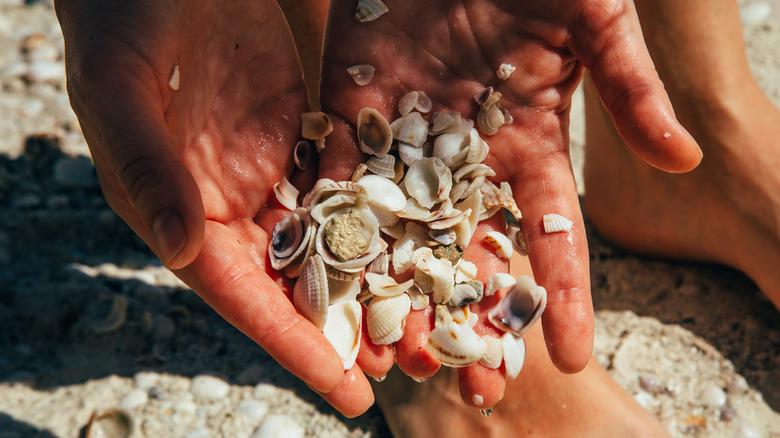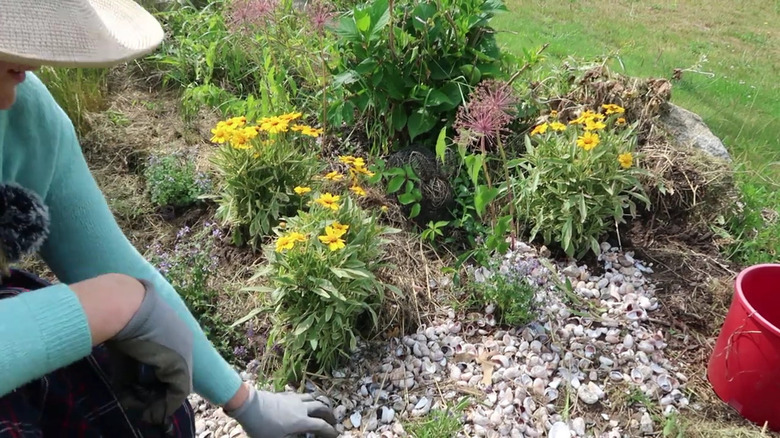This Beachy Mulch Alternative Is Beautiful But Can Have A Stinky Problem
In your search for natural DIY weed barrier alternatives to landscaping fabric, you've likely come across seashell mulch. It reportedly has a ton of benefits for the garden, from the aforementioned weed control to providing your plants with much-needed calcium and reducing soil acidity. Not to mention its sustainability — oyster shells, for example, are an agricultural waste product. What's not to like? Well, some gardeners report shell mulch (with oysters, clams, and scallops most often used in the U.S.), gives off a decidedly unpleasant odor. The stink associated with this organic garden coverage alternative is caused by the decomposing tiny bits of the creatures that once called the shells their home — be that the shellfish themselves or hitchhikers like barnacles.
Gardeners might consider using it for quite a few different beneficial reasons. Add this bivalve shell to your garden for a nutritional boost; as seashells break down, they reduce soil acidity and add essential nutrients like calcium, magnesium, iodine, and bromine. Some garden gurus consider them a useful pest repeller, as everything from slugs, snails, and nematodes to voles reportedly hate interacting with them. In a more niche example, a 2017 study in Agronomy for Sustainable Development found that mussel shell mulch in the New Zealand wine industry reduced scarab beetle predation by deterring them from landing in vineyards.
The shell mulch landscape suppliers sell should be odor-free
If you're concerned about potential smells when using shell mulch in your garden, buy your pearly mulch from commercial sources, like, say, a landscaping materials supplier. The unpleasant odors will be low or completely eliminated. For one, because seashells destined for landscaping are typically so-called waste from the aquaculture industry, the shellfish inside has been removed. It's food, after all. Once they arrive at the supplier, they're washed and dried, possibly over the course of a season or more, before being bagged for sale and delivered to you, the gardener. If there's any residual odor left, it'll be minimal and last a few days at most, suppliers assure. Shells sourced from commercial fishing are considered sustainable.
If you collect seashell mulch yourself from, say, a private beach, the answer to the question may be different. If you're adding a handful to the top of a potted plant, fine. But if you're using it in enormous quantities — for, perhaps, an extensive backyard garden bed — the smell may be overpowering. That's because you can't be certain there are no once-living parts still left in the shells. For example, research undertaken in New Zealand exploring using waste mussel shells in city landscaping projects found the odor, at least in areas with less airflow, to be rather disagreeable. If you're dealing with only handfuls or bucket loads of the stuff, not truckloads, the solution lies in ridding the bivalve casings of their inhabitants completely.
How to get rid of the stench from fresh shell mulch
Boil the shells for about five minutes to loosen any biological material, dump the shells out of the pot of hot water (use protection to avoid burning yourself), and leave them to dry on a rack or newspaper sheets. You can also soak the shells overnight or longer in 1 part bleach to 9 parts water or 70% or 90% rubbing alcohol. This is similar to the process commercially supplied shell mulch undergoes, albeit on a much smaller scale.
Does collecting wild shells eliminate this material from the list of eco-friendly mulch options? In a lot of places in the U.S., it's okay to collect a few empty shells for personal use, but regulations vary widely. Nothing should be living inside your finds. However, always check with your specific municipal authority before heading out to the shore with a shovel and bucket. Whether it's legal or not in your state or area is one thing. With mollusk populations in decline and other creatures in the ecosystem relying on shells, you also need to consider the ethical ramifications.
If this all seems like way too much fuss, talk to a local mulch supplier. Seashell mulch is typically delivered by truck and prices vary state-to-state. For example, West Marin Compost in California sells Marin oyster shells for $250 per cubic yard. By contrast, Odessa-based PAW Materials sells small washed and crushed seashells for $105 per cubic yard.


